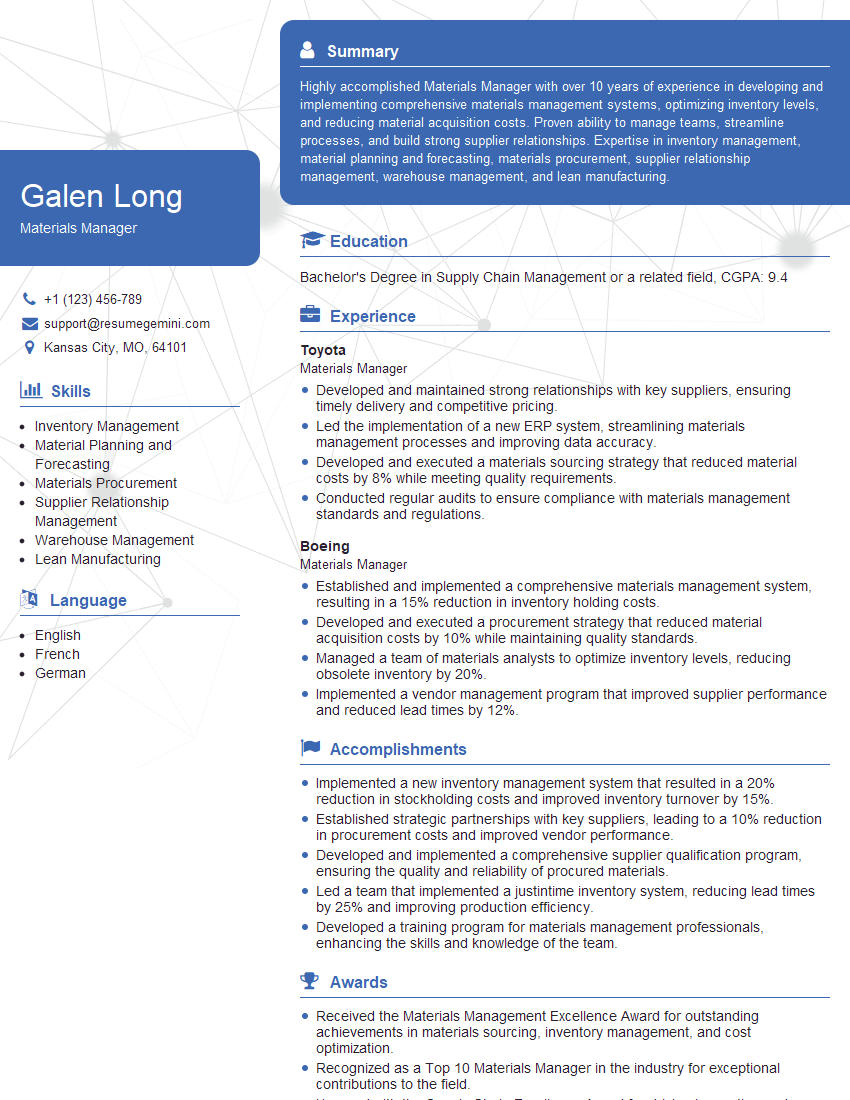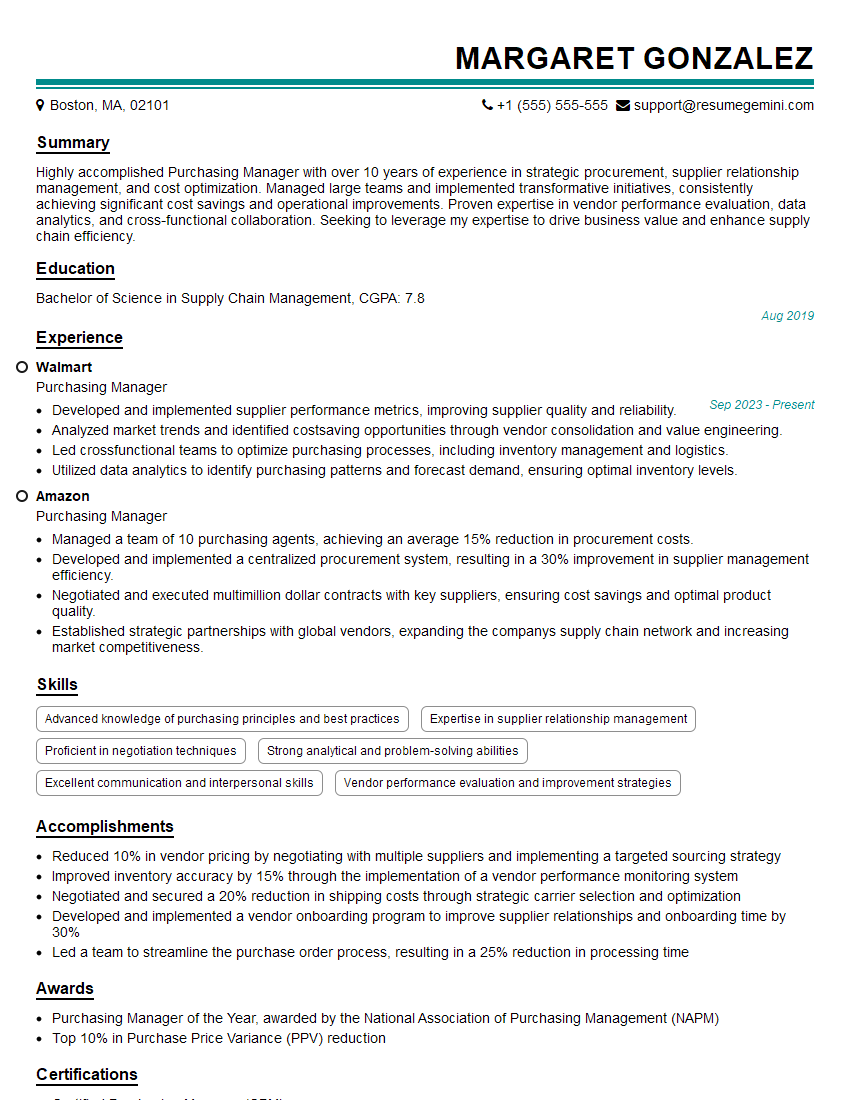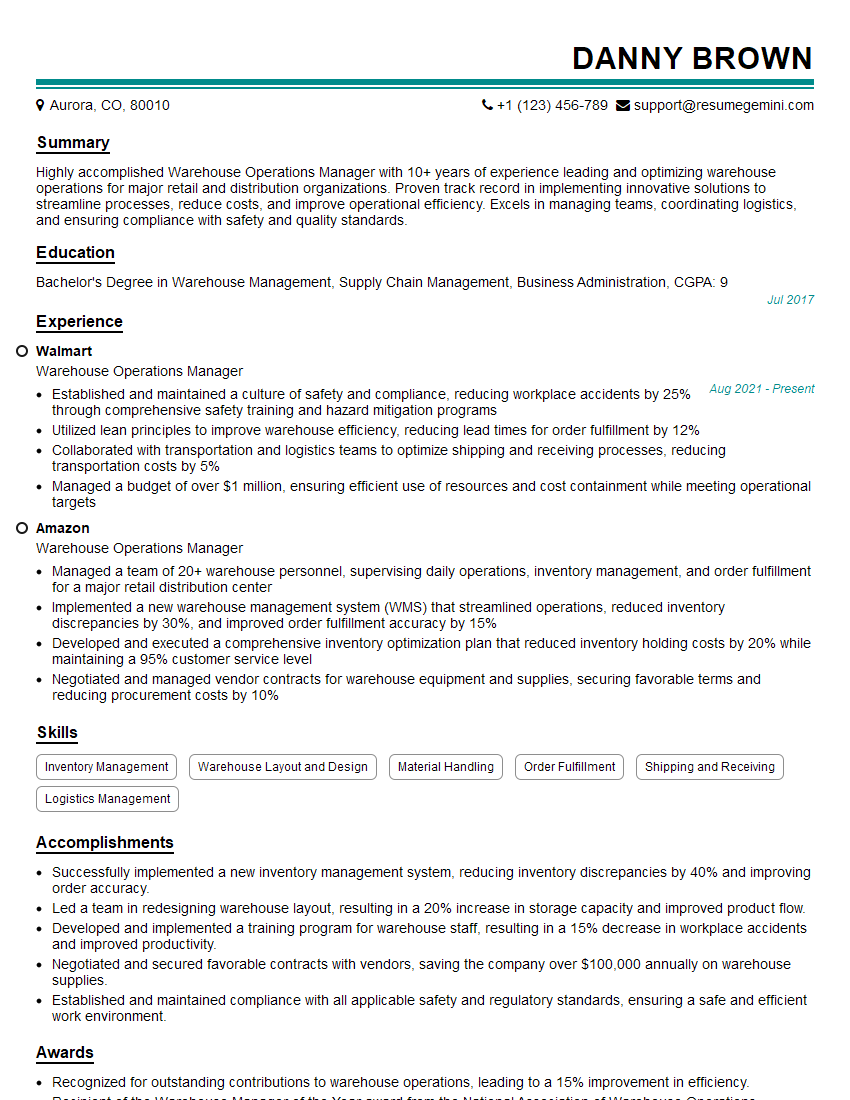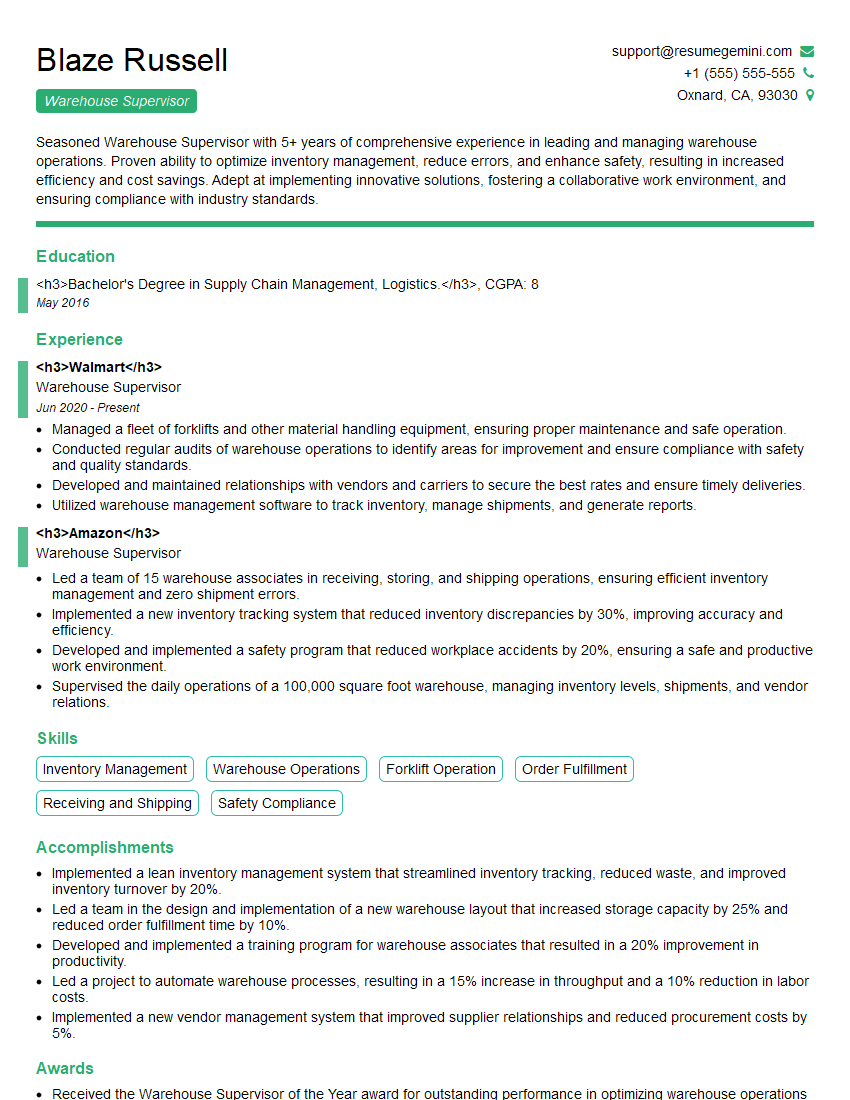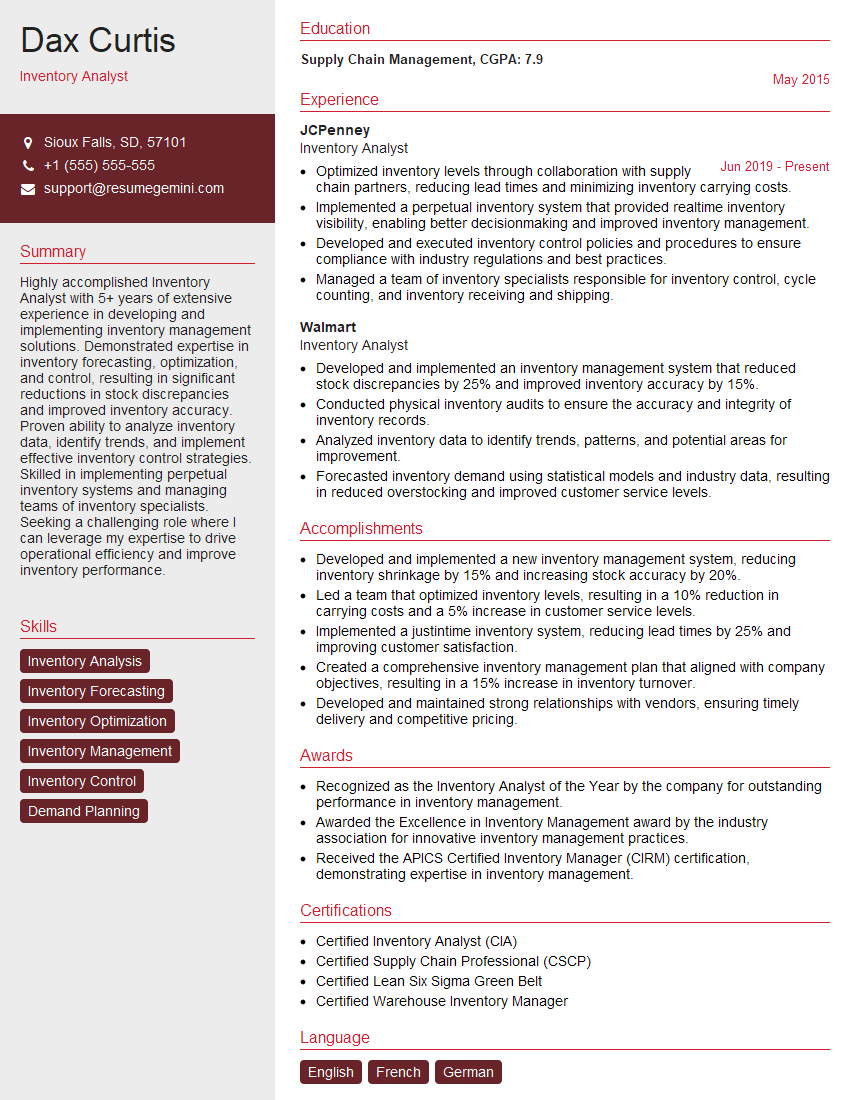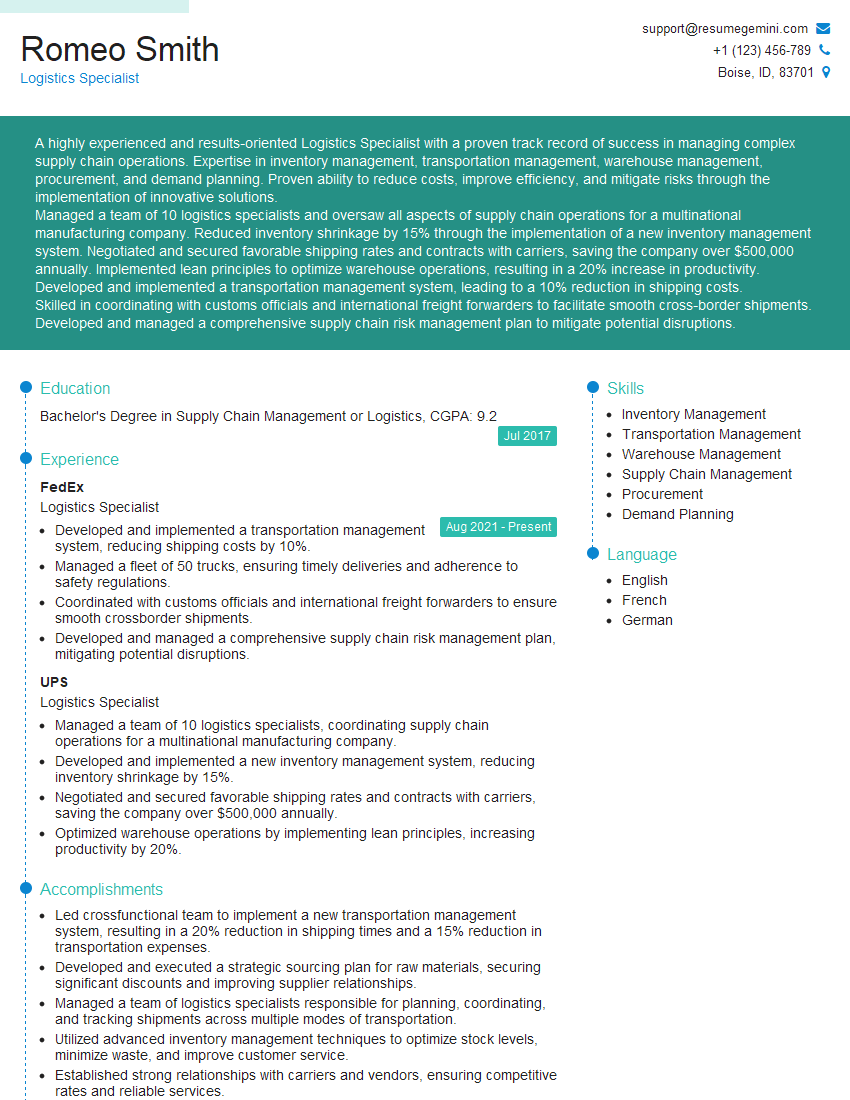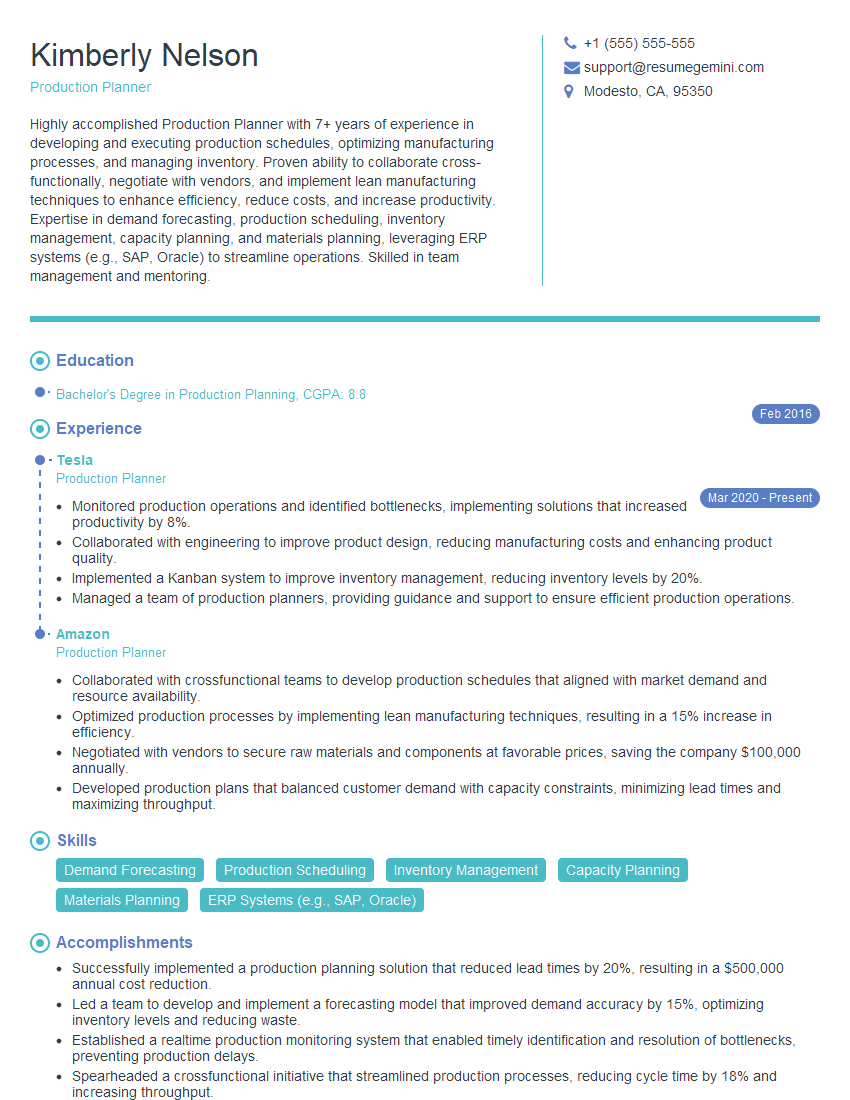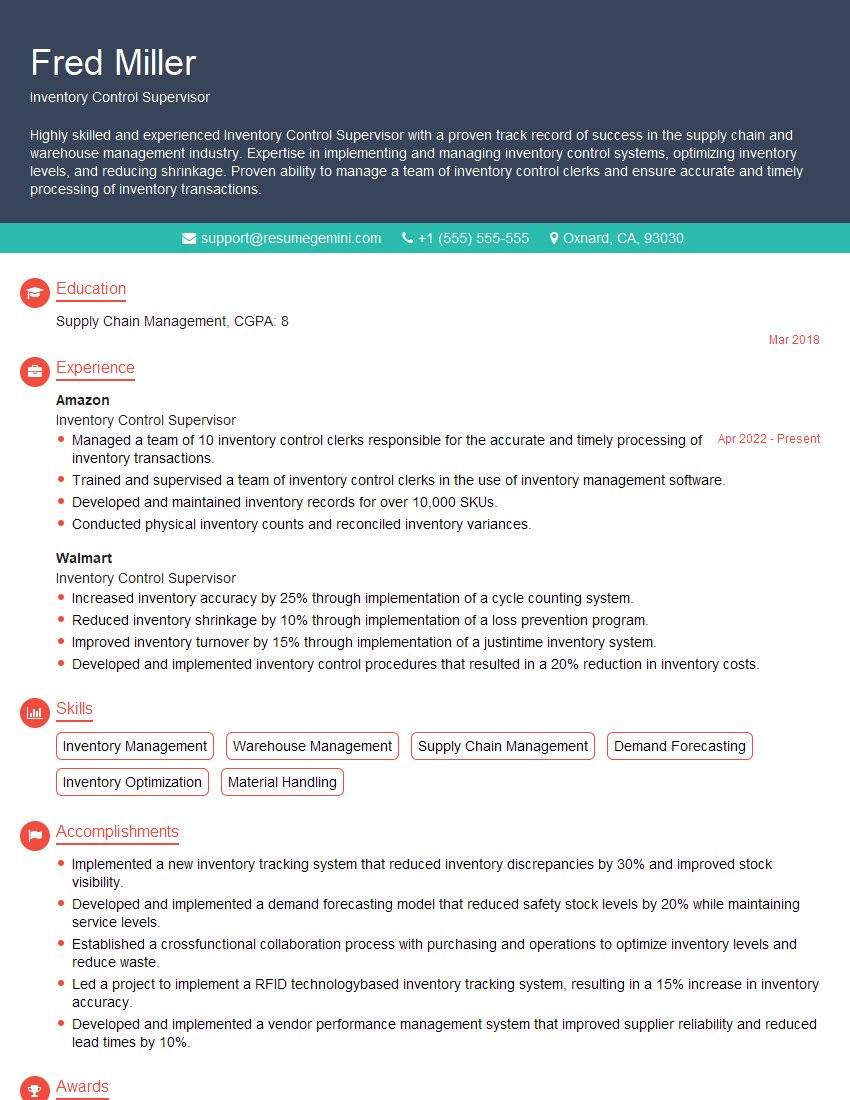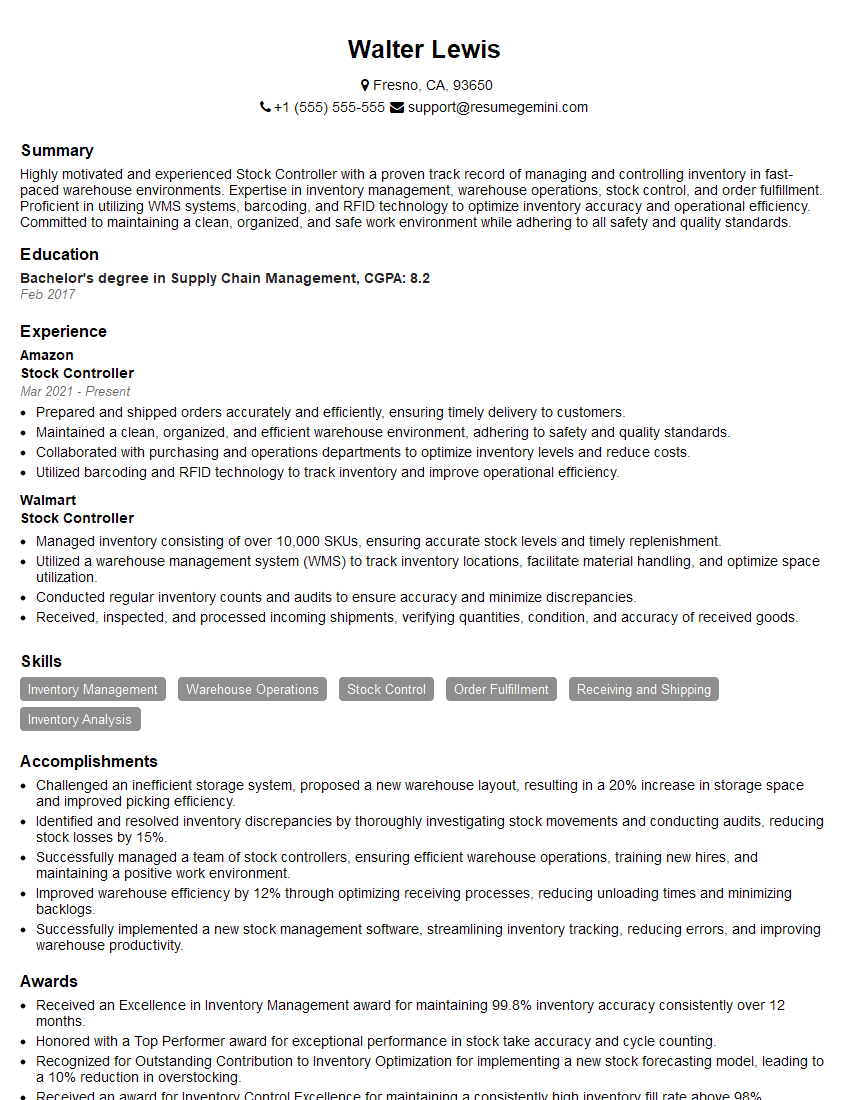The right preparation can turn an interview into an opportunity to showcase your expertise. This guide to Familiarity with Inventory Management Techniques interview questions is your ultimate resource, providing key insights and tips to help you ace your responses and stand out as a top candidate.
Questions Asked in Familiarity with Inventory Management Techniques Interview
Q 1. Explain the difference between FIFO and LIFO inventory valuation methods.
FIFO (First-In, First-Out) and LIFO (Last-In, First-Out) are two common methods for valuing inventory. They impact how the cost of goods sold (COGS) and ending inventory are calculated, significantly affecting a company’s financial statements. The core difference lies in the order in which inventory is assumed to be sold.
FIFO: Imagine a bakery. The first batch of croissants you bake are the first ones you sell. With FIFO, the cost of the oldest inventory items is assigned to COGS, and the cost of the newest items remains in ending inventory. This means during periods of inflation, FIFO results in a lower COGS (because older, cheaper items are sold first), leading to higher net income and higher taxes. However, ending inventory reflects current market prices.
LIFO: Sticking with the bakery, imagine you’re selling the last batch of croissants first. In LIFO, the cost of the newest inventory items is assigned to COGS, while the cost of the oldest items remains in ending inventory. During inflation, LIFO leads to a higher COGS (because newer, more expensive items are sold first), resulting in lower net income and lower taxes. Ending inventory, however, understates the current market value.
Example: Let’s say you purchased 10 units at $10 each and later 10 units at $12 each. If you sell 5 units using FIFO, COGS is 5 * $10 = $50. Using LIFO, COGS is 5 * $12 = $60.
Q 2. Describe your experience with inventory management software.
I have extensive experience using various inventory management software, including NetSuite, SAP, and Fishbowl Inventory. My experience spans implementing, configuring, and optimizing these systems for diverse businesses, from small retail stores to large manufacturing plants. My proficiency includes data entry, reporting, forecasting, and integrating the software with other business systems like ERP and CRM. For instance, in my previous role at Acme Manufacturing, I spearheaded the implementation of NetSuite, streamlining our inventory processes and reducing discrepancies by 15% within the first six months. This involved customizing the system to meet our specific needs, training staff, and developing robust reporting dashboards to monitor key performance indicators.
I’m adept at configuring automated alerts for low stock levels, generating accurate inventory reports, managing cycle counting procedures, and optimizing warehouse layout within the software. This also extends to integrating inventory management with purchasing and sales systems to maintain accurate stock levels while avoiding stockouts or overstocking. My focus has always been on choosing and utilizing software that best supports the specific business processes and scales effectively with growth.
Q 3. How do you calculate inventory turnover rate?
The inventory turnover rate measures how efficiently a company sells its inventory during a given period. A higher turnover rate generally indicates strong sales and efficient inventory management. It’s calculated as:
Inventory Turnover Rate = Cost of Goods Sold (COGS) / Average Inventory
The average inventory is usually calculated by averaging the beginning and ending inventory values for the period (e.g., a year or a quarter): (Beginning Inventory + Ending Inventory) / 2
Example: If COGS for the year was $100,000, and the average inventory was $25,000, the inventory turnover rate is: $100,000 / $25,000 = 4. This means the company sold and replaced its entire inventory four times during the year.
Q 4. What are the key performance indicators (KPIs) you use to monitor inventory performance?
Several KPIs are crucial for monitoring inventory performance. These help assess efficiency, identify areas for improvement, and make data-driven decisions.
- Inventory Turnover Rate: As discussed previously, this measures how quickly inventory is sold.
- Gross Profit Margin: This helps to understand the profitability of sales and how pricing strategies influence the bottom line.
- Inventory Holding Cost: This represents the total cost of storing and maintaining inventory (storage, insurance, obsolescence, etc.). Reducing this cost is a major goal of efficient inventory management.
- Stockout Rate: The percentage of times an item was out of stock when demanded. This directly impacts customer satisfaction and sales.
- Fill Rate: This measures the percentage of customer demand fulfilled from available inventory. A high fill rate indicates effective inventory management.
- Order Fulfillment Cycle Time: The time it takes to process an order from receipt to delivery. Shorter cycle times indicate efficiency.
- Inventory Accuracy: The percentage of inventory records that accurately reflect the physical inventory. High accuracy indicates reliable data for decision-making.
By closely monitoring these KPIs, I can identify trends, bottlenecks, and opportunities for improvement in the inventory management system.
Q 5. How do you handle inventory discrepancies?
Inventory discrepancies—differences between recorded inventory and physical inventory—are common. Addressing them requires a systematic approach.
- Regular Cycle Counting: This involves counting a small portion of the inventory regularly, rather than a full inventory count annually. This allows for early detection and correction of discrepancies.
- Root Cause Analysis: Investigate the reasons behind the discrepancies. Common causes include data entry errors, theft, damage, or inaccurate recording of stock movements.
- Inventory Reconciliation: Adjust the inventory records to match the physical count. This might involve writing off damaged or obsolete items.
- Process Improvement: Implement measures to prevent future discrepancies. This could include improved data entry procedures, better security measures, or enhanced training for warehouse staff.
- Technology: Utilizing barcode scanners, RFID tags, and inventory management software can significantly reduce errors and improve accuracy.
For example, if a significant discrepancy is found, I’d initiate a thorough investigation, possibly involving staff interviews and security footage reviews, to identify the cause and implement corrective actions.
Q 6. Explain the concept of safety stock and how it’s determined.
Safety stock is the extra inventory held to buffer against unexpected demand or supply chain disruptions. It ensures that you can meet customer demand even if there are delays in receiving shipments or if demand unexpectedly surges. Determining the appropriate safety stock level involves considering several factors:
- Demand Variability: How much does demand fluctuate? Higher variability requires more safety stock.
- Lead Time Variability: How much does the time to receive new inventory fluctuate? Longer and more variable lead times necessitate more safety stock.
- Service Level: The desired probability of meeting demand during lead time. A higher service level (e.g., 99%) requires more safety stock.
There are several methods for calculating safety stock, often involving statistical techniques like standard deviation and forecasting. A simple approach is to use a fixed percentage of expected demand during the lead time. For example, if the average lead time demand is 100 units and you want a 20% safety stock, you would maintain an additional 20 units. More sophisticated methods take into account demand variability and lead time uncertainty using statistical modeling techniques.
Q 7. What are some common inventory management challenges and how have you overcome them?
Common inventory management challenges include inaccurate forecasting, inefficient warehouse operations, obsolete inventory, and lack of real-time visibility. I’ve tackled these in several ways:
- Inaccurate Forecasting: I improved forecasting accuracy by implementing demand planning processes using historical data, market trends, and sales projections. This involved collaborating with sales and marketing teams to gain a comprehensive understanding of future demand.
- Inefficient Warehouse Operations: I’ve streamlined warehouse operations by optimizing layouts, implementing lean principles (e.g., 5S), and investing in technology like warehouse management systems (WMS) to automate tasks and improve efficiency.
- Obsolete Inventory: I addressed obsolete inventory by implementing regular inventory reviews, identifying slow-moving items, and implementing strategies to liquidate or dispose of them appropriately. This often involves close collaboration with the sales and marketing teams to clear out slower moving items through strategic pricing or promotional offers.
- Lack of Real-time Visibility: I improved visibility by implementing real-time inventory tracking systems using barcode scanners, RFID tags, and integrated inventory management software. This provided accurate data for decision-making and better control over inventory levels.
Successfully overcoming these challenges requires a blend of process improvement, technological solutions, and a data-driven approach.
Q 8. Describe your experience with cycle counting.
Cycle counting is a widely used inventory management technique that involves regularly counting a small subset of inventory items rather than conducting a full inventory count at once. It’s far more efficient and less disruptive than a full inventory count, and its ongoing nature provides better accuracy over time.
In my experience, I’ve implemented and managed cycle counting programs in various settings. For example, in a previous role at a large distribution center, we implemented a cycle counting schedule based on ABC analysis (explained further below). High-value (A items) were counted weekly, medium-value (B items) bi-weekly, and low-value (C items) monthly. This targeted approach maximized accuracy where it mattered most while minimizing the time commitment. We also used barcode scanners to streamline the process and reduce errors, integrating the data directly into our inventory management system. The system automatically generated reports highlighting discrepancies, which facilitated prompt investigation and correction.
The key to successful cycle counting lies in developing a well-structured schedule, clear procedures, and rigorous training for the counting personnel. Regular review and adjustment of the schedule, based on data analysis, is also vital to ensure optimal efficiency and accuracy.
Q 9. How do you forecast inventory needs?
Inventory forecasting is crucial for effective inventory management. It involves predicting future demand for inventory items to ensure sufficient stock while minimizing excess inventory and storage costs. My approach typically involves a combination of methods:
- Historical Data Analysis: This involves analyzing past sales data, identifying trends, seasonality, and patterns to extrapolate future demand. For example, analyzing sales data from the past three years, including seasonal fluctuations and promotions, allows for a more accurate forecast than relying on a single year’s data.
- Market Research and Trends: Keeping up-to-date with market trends, economic indicators, and competitor activity helps refine demand projections. For example, understanding the impact of upcoming economic changes or a new competitor product launch can significantly influence forecast accuracy.
- Sales Forecasts: Collaborating with the sales team provides valuable insight into anticipated customer orders and market opportunities. Their qualitative input complements quantitative data analysis.
- External Factors: Considering external factors like weather patterns (for seasonal goods), supply chain disruptions, and geopolitical events, is vital for building robust and resilient forecasts.
The chosen forecasting method often depends on the specific item and data availability. Simple methods like moving averages might suffice for slow-moving items, while more sophisticated techniques such as exponential smoothing or ARIMA models are useful for items with complex demand patterns. Regularly reviewing and adjusting forecasts based on actual sales is essential to maintain accuracy.
Q 10. What is ABC analysis and how is it used in inventory management?
ABC analysis is a popular inventory management technique that categorizes inventory items based on their consumption value. It’s based on the Pareto principle (80/20 rule), suggesting that approximately 80% of your total consumption value comes from approximately 20% of your inventory items.
- A-items: These are high-value items representing a significant portion of your total inventory value. They typically account for about 20% of items but contribute to roughly 80% of total value. These items require strict monitoring, tight control, and frequent reviews.
- B-items: These represent the middle ground, with moderate consumption value and inventory levels. They require less attention than A-items but still warrant regular monitoring.
- C-items: These are low-value items contributing only a small percentage to the total inventory value. They require minimal monitoring, and stock-outs are generally less critical.
ABC analysis helps prioritize inventory management efforts by focusing attention and resources where they have the most impact. For instance, A-items might require more sophisticated forecasting and tighter control over lead times, while C-items can benefit from simpler, less frequent monitoring. This approach optimizes inventory management and reduces overall costs.
Q 11. Explain your understanding of just-in-time (JIT) inventory management.
Just-in-time (JIT) inventory management is a strategy that aims to minimize inventory holding costs by receiving materials only when they are needed for production or sale. It’s a highly efficient system that relies on close collaboration with suppliers and precise demand forecasting.
The core principles of JIT include:
- Minimizing Waste: Reducing all forms of waste, including excess inventory, idle time, and defects.
- Continuous Improvement: Constantly seeking ways to refine processes and improve efficiency.
- Supplier Partnerships: Establishing strong relationships with reliable suppliers who can deliver high-quality materials on time.
- Pull System: Production is triggered by actual customer demand, rather than relying on forecasts.
Successfully implementing JIT requires a high degree of coordination and a robust, reliable supply chain. Any disruption in the supply chain can severely impact production, highlighting the importance of having strong contingency plans. A classic example of successful JIT implementation is Toyota’s production system.
Q 12. How do you manage obsolete or slow-moving inventory?
Managing obsolete or slow-moving inventory is critical to avoid tying up capital and resources. My approach involves several strategies:
- Identification and Analysis: Regularly reviewing inventory reports to identify slow-moving and obsolete items. Analyzing the reasons for slow movement (e.g., changes in market demand, technological advancements, or poor forecasting) helps in developing appropriate strategies.
- Price Reductions and Promotions: Offering discounts or running promotions to accelerate the sale of slow-moving items. This helps recover some of the invested capital.
- Liquidation and Disposal: If price reductions are ineffective, considering liquidation through auctions, online marketplaces, or other channels. Obsolete items might need proper disposal, following environmental regulations.
- Return to Suppliers: Exploring the option of returning obsolete inventory to suppliers, especially if they offer return policies or take-back programs.
- Repurposing or Refurbishment: In some cases, it’s possible to repurpose or refurbish obsolete items and sell them at a different price point.
The optimal strategy depends on the specific items and their market value. The goal is to minimize losses while freeing up resources for more profitable inventory.
Q 13. What is the economic order quantity (EOQ) and how do you calculate it?
The economic order quantity (EOQ) is the optimal order quantity that minimizes the total inventory costs, including ordering costs and holding costs. It’s a crucial concept in inventory management that helps companies determine the most cost-effective order size.
The EOQ formula is:
EOQ = √[(2DS)/H]Where:
- D = Annual demand
- S = Ordering cost per order
- H = Holding cost per unit per year
For example, if the annual demand (D) is 1000 units, the ordering cost (S) is $50 per order, and the holding cost (H) is $10 per unit per year, the EOQ would be:
EOQ = √[(2 * 1000 * 50) / 10] = 100 unitsThis means that ordering 100 units at a time would minimize the total inventory costs. It’s important to note that the EOQ model assumes constant demand and stable lead times, which might not always be the case in real-world scenarios. However, it serves as a valuable starting point for determining optimal order quantities.
Q 14. How do you ensure inventory accuracy?
Ensuring inventory accuracy is paramount for effective inventory management. This involves several key practices:
- Regular Cycle Counting: As discussed earlier, cycle counting is essential for identifying and correcting discrepancies in a timely manner.
- Barcode and RFID Technology: Using barcode or RFID scanners for efficient and accurate item tracking during receiving, storage, and shipping. This minimizes manual data entry errors.
- Inventory Management System (IMS): Implementing a robust IMS that tracks inventory levels in real-time, integrating data from different points in the supply chain.
- Proper Stock Rotation: Implementing FIFO (First-In, First-Out) or other inventory management methods to reduce spoilage and obsolescence.
- Employee Training: Training employees on proper inventory handling procedures, including accurate data entry and reporting of discrepancies.
- Regular Audits: Conducting regular inventory audits to verify the accuracy of the inventory records and identify areas for improvement. A full physical inventory count should be conducted periodically to confirm the accuracy of the IMS.
By combining these techniques, companies can achieve a high level of inventory accuracy, preventing stockouts, minimizing losses, and enhancing overall operational efficiency.
Q 15. Describe your experience with RFID or barcode technology in inventory management.
RFID (Radio-Frequency Identification) and barcode technology are crucial for efficient inventory management. Barcodes use optical scanners to read linear codes, providing basic item identification. RFID, however, uses radio waves to transmit data from tags attached to items, enabling automatic identification and tracking without line-of-sight. My experience includes implementing both systems. In a previous role, we transitioned from a purely barcode-based system to one incorporating RFID for high-value items. This significantly improved accuracy in stock counts, reduced manual labor, and allowed for real-time tracking of items throughout the warehouse, eliminating the need for frequent physical inventory checks. For example, we were able to quickly locate and identify misplaced high-value components during a period of high order volume, preventing significant delays and revenue loss. With barcodes, this process would have been much more time-consuming and prone to error.
The choice between RFID and barcode depends on factors like budget, item value, required tracking accuracy, and the nature of the inventory. Barcode systems are cost-effective for low-value, high-volume items where real-time tracking isn’t critical. RFID is ideal for high-value items, temperature-sensitive goods, or situations requiring precise location tracking and inventory visibility.
Career Expert Tips:
- Ace those interviews! Prepare effectively by reviewing the Top 50 Most Common Interview Questions on ResumeGemini.
- Navigate your job search with confidence! Explore a wide range of Career Tips on ResumeGemini. Learn about common challenges and recommendations to overcome them.
- Craft the perfect resume! Master the Art of Resume Writing with ResumeGemini’s guide. Showcase your unique qualifications and achievements effectively.
- Don’t miss out on holiday savings! Build your dream resume with ResumeGemini’s ATS optimized templates.
Q 16. How do you handle inventory shortages?
Handling inventory shortages requires a multi-pronged approach. The first step is identifying the cause. Is it due to inaccurate forecasting, unexpected demand spikes, supplier delays, or internal theft? Once the root cause is identified, I implement corrective actions. This might involve:
- Improving demand forecasting: Utilizing more sophisticated forecasting models that account for seasonality, trends, and external factors.
- Strengthening supplier relationships: Establishing stronger communication channels and contingency plans to mitigate supplier disruptions. This includes negotiating minimum order quantities and exploring alternative suppliers.
- Enhancing internal processes: Implementing stricter inventory control procedures, improving stock-taking accuracy, and investigating potential internal causes of shortages.
- Backordering or expediting: For immediate shortages, I prioritize customer orders based on urgency and explore options for expediting shipments or backordering items, keeping customers informed throughout the process.
- Substitute products: If appropriate, offering alternative products to customers to fulfill their needs.
Regular inventory reviews and analysis are crucial to prevent future shortages. The goal is to identify and correct systematic issues, not just treat the symptoms.
Q 17. Explain your understanding of inventory carrying costs.
Inventory carrying costs represent the total cost of storing and maintaining inventory. These costs are significant and often overlooked. They include:
- Storage costs: Rent, utilities, insurance, and security for warehouse space.
- Capital costs: The opportunity cost of tying up capital in inventory rather than investing it elsewhere.
- Obsolescence costs: The potential loss of value due to product obsolescence or spoilage, particularly relevant for perishable goods or rapidly changing technology.
- Insurance costs: Protecting inventory against damage, theft, or loss.
- Taxes: Property taxes on inventory stored in a warehouse.
- Handling costs: Labor costs associated with moving, receiving, and managing inventory.
Understanding these costs is vital for optimizing inventory levels. High carrying costs can erode profitability, whereas inadequate inventory levels can lead to lost sales. The goal is to find the optimal balance that minimizes total inventory costs.
Q 18. How do you improve inventory turnover?
Improving inventory turnover – the rate at which inventory is sold and replenished – is crucial for profitability. A higher turnover indicates efficient inventory management. Strategies to enhance inventory turnover include:
- Accurate demand forecasting: Reducing forecast errors leads to more accurate ordering, minimizing excess inventory.
- Efficient order fulfillment: Streamlining the order-to-delivery process reduces lead times and improves customer satisfaction.
- Optimized pricing strategies: Strategic pricing can stimulate demand and accelerate inventory movement.
- Regular inventory reviews: Identifying slow-moving items and implementing strategies like markdowns, promotions, or discontinuation.
- Improved supplier relationships: Securing reliable and timely deliveries reduces stockouts and unnecessary safety stock.
- Effective inventory control system: Implementing a robust system using software such as an ERP to track inventory levels in real-time and generate accurate reports.
By focusing on these areas, businesses can reduce carrying costs, free up capital, and improve overall efficiency.
Q 19. What is your experience with different inventory models (e.g., EOQ, Reorder Point)?
I’m proficient in various inventory models. The Economic Order Quantity (EOQ) model helps determine the optimal order quantity to minimize total inventory costs. It balances ordering costs and holding costs. The formula is: EOQ = √(2DS/H), where D is annual demand, S is ordering cost per order, and H is holding cost per unit per year.
The Reorder Point (ROP) model identifies the inventory level at which a new order should be placed. It considers lead time demand and safety stock: ROP = Lead Time Demand + Safety Stock. Safety stock acts as a buffer against demand uncertainty and lead time variability.
I have applied these models in numerous scenarios, adapting them to the specific characteristics of different products and market conditions. For instance, in a previous role, using EOQ and ROP for our most popular product line allowed us to reduce inventory holding costs by 15% while maintaining adequate stock levels to meet customer demand.
Q 20. Describe a time you had to make a difficult decision regarding inventory levels.
In a previous role, we faced a challenging decision regarding inventory levels for a newly launched product. Initial sales were significantly higher than projected, leading to a rapid depletion of stock. We had two options: increase production immediately at a higher cost, risking potential overstocking if demand slowed, or maintain the current production schedule and risk losing significant sales and market share.
After analyzing the situation, considering customer demand trends, and assessing the risks associated with both options, we chose to increase production gradually. We opted for a phased approach, closely monitoring sales data and adjusting production accordingly. This mitigated the risk of significant overstocking while ensuring that we met the majority of customer demands. This decision required careful analysis, risk assessment, and close collaboration with the production and sales teams. Although it involved a higher upfront cost, the strategy ultimately proved successful, as we avoided both substantial stockouts and excessive surplus inventory.
Q 21. How do you collaborate with other departments (e.g., purchasing, sales) regarding inventory management?
Collaboration with other departments is essential for effective inventory management. I regularly work with the purchasing department to ensure timely procurement of materials and manage supplier relationships. Accurate sales forecasts are critical; therefore, close collaboration with the sales team is paramount to anticipate demand fluctuations and avoid stockouts or overstocking.
I utilize various tools to facilitate this collaboration, including regular meetings, shared dashboards displaying key inventory metrics (like inventory turnover and stock levels), and collaborative software platforms to track orders, forecast demand, and share updates on inventory levels and potential issues. Open communication and a shared understanding of inventory goals are key to this process. For example, regular sales forecasts meetings with the sales team allowed us to anticipate seasonal peaks in demand and ensure sufficient inventory was available.
Q 22. What are the benefits and drawbacks of using a centralized versus decentralized inventory management system?
Centralized versus decentralized inventory management involves a fundamental decision about control and responsibility for stock. A centralized system manages inventory from a single location, providing a clear overview and tighter control. A decentralized system distributes inventory management across multiple locations, often closer to points of use.
- Centralized Benefits: Better overview of total inventory, reduced duplication of effort, easier implementation of consistent policies, and potentially lower overall costs due to economies of scale.
- Centralized Drawbacks: Slower response to localized demand fluctuations, potential for bottlenecks in the central location, increased reliance on accurate and timely communication between locations, and a higher risk of disruption if the central system fails.
- Decentralized Benefits: Faster response to localized demand, greater flexibility in managing diverse product lines or geographical regions, reduced risk of widespread disruption from a single event, and potentially improved customer service through faster fulfillment.
- Decentralized Drawbacks: Higher administrative overhead due to multiple systems, potential for inconsistencies in inventory management practices, increased risk of stockouts or overstocking in individual locations, and more challenging to obtain a true picture of overall inventory levels.
For example, a large retail chain might use a centralized system for managing high-demand items but a decentralized system for managing regionally specific products. The best choice depends heavily on the company’s size, structure, and the nature of its products and markets.
Q 23. How do you manage inventory across multiple locations?
Managing inventory across multiple locations requires a robust system that integrates data from all sites. This typically involves:
- Centralized Database: A single, unified database to track inventory levels across all locations in real-time. This could be a cloud-based solution or a sophisticated on-premise system.
- Real-Time Data Synchronization: Systems must constantly update inventory levels as items are received, sold, or transferred between locations. This requires robust data transfer mechanisms to ensure accuracy.
- Inventory Tracking Software: Specialized software is crucial for managing stock levels, generating reports, and managing transactions. Features such as barcode or RFID scanning can improve accuracy and speed.
- Optimized Inventory Transfer Procedures: Clear protocols are needed for transferring inventory between locations, including documentation, tracking, and communication. This might involve using dedicated transportation systems or third-party logistics providers.
- Demand Forecasting: Accurately predicting demand at each location is key. Sophisticated forecasting models can help optimize inventory levels and reduce waste.
Imagine a company with warehouses in New York, Los Angeles, and Chicago. The system should allow them to see total stock for a given product, instantly transfer stock from Chicago to Los Angeles if needed, and identify slow-moving items in New York. This requires advanced integration and reporting capabilities.
Q 24. How do you use data analytics to improve inventory management?
Data analytics is transformative for inventory management. By analyzing historical sales data, demand forecasts, and other relevant metrics, we can significantly improve efficiency and reduce costs. This includes:
- Demand Forecasting: Using time series analysis, machine learning, or other statistical methods to predict future demand, allowing for proactive inventory adjustments.
- Inventory Optimization: Identifying slow-moving or obsolete items, optimizing order quantities (EOQ), and determining optimal safety stock levels to minimize storage costs while mitigating risk of stockouts.
- Supply Chain Analysis: Analyzing lead times, supplier performance, and transportation costs to identify areas for improvement and cost reduction.
- Performance Monitoring: Tracking key metrics such as inventory turnover rate, fill rate, and stockout frequency to identify areas needing attention and measure the effectiveness of improvements.
For example, by analyzing sales data, we might discover a seasonal spike in demand for a particular product. This insight allows us to proactively increase inventory levels before the peak season, avoiding stockouts and lost sales opportunities. Similarly, analyzing slow-moving items allows us to reduce purchasing and storage costs. Tools such as Excel, specialized inventory management software, or business intelligence platforms are invaluable for this.
Q 25. Explain your experience with implementing new inventory management systems or processes.
In my previous role, we implemented a new cloud-based inventory management system to replace our outdated on-premise solution. The process involved:
- Needs Assessment: We carefully evaluated our existing system’s shortcomings and defined our requirements for the new system.
- Vendor Selection: We thoroughly researched and evaluated various vendors based on cost, features, scalability, and integration capabilities.
- System Implementation: We worked closely with the vendor’s implementation team to configure the new system, migrate data, and train our staff.
- Testing and Validation: We performed rigorous testing to ensure the system’s accuracy and functionality before going live.
- Post-Implementation Review: We monitored the system’s performance after launch, addressing any issues and making adjustments as needed. We also gathered feedback from users to improve adoption and effectiveness.
This project significantly improved our inventory accuracy, reduced manual data entry errors, and streamlined our reporting processes. It also improved collaboration across different departments, giving everyone real-time visibility into inventory levels.
Q 26. How do you prioritize inventory tasks and manage your time effectively?
Prioritizing inventory tasks and managing time effectively requires a structured approach. I utilize several techniques:
- Prioritization Matrix: I use a matrix (e.g., Eisenhower Matrix) to categorize tasks based on urgency and importance. This helps me focus on high-impact activities first.
- Task Scheduling: I use a task management system (e.g., project management software or even a simple to-do list) to schedule tasks and allocate time efficiently. This ensures that deadlines are met.
- Regular Reviews: I regularly review my progress, adjusting priorities as needed to address unexpected issues or changes in circumstances.
- Delegation: Where possible, I delegate tasks to others to free up my time for higher-level activities. This requires clear communication and training.
- Automation: I leverage automation tools to streamline routine tasks such as data entry and report generation, freeing up time for more strategic initiatives.
For instance, I might prioritize addressing a critical stockout situation over performing a routine inventory analysis. By strategically managing my time, I ensure that crucial tasks are addressed promptly while less urgent items are handled efficiently.
Q 27. Describe your experience with inventory audits.
Inventory audits are crucial for maintaining accuracy and identifying discrepancies. My experience involves:
- Planning and Preparation: Carefully planning the audit scope, selecting appropriate audit methods (e.g., cycle counting, full physical count), and assembling the necessary resources (personnel, equipment).
- Execution: Systematically counting and verifying inventory against records, documenting discrepancies, and investigating their causes.
- Reconciliation: Reconciling physical inventory counts with recorded inventory levels, identifying and correcting discrepancies.
- Reporting: Preparing detailed audit reports summarizing findings, identifying root causes of discrepancies, and recommending corrective actions.
- Follow-up: Following up on corrective actions to ensure that discrepancies are resolved and processes are improved.
I’ve been involved in both full physical inventory counts (often done annually) and cycle counting (a more frequent, smaller-scale process focused on high-value or high-turnover items). The goal is not just to identify errors but also to understand the underlying causes, such as process inefficiencies or data entry mistakes, and to implement changes to prevent recurrence.
Q 28. How do you stay updated on the latest trends and best practices in inventory management?
Staying updated on inventory management trends requires a multifaceted approach:
- Industry Publications and Journals: Regularly reading industry publications and journals to stay abreast of new technologies, best practices, and emerging trends. This includes both print and online resources.
- Conferences and Webinars: Attending industry conferences and webinars to learn from experts and network with peers. This provides opportunities to see real-world applications and discuss challenges with others.
- Online Courses and Certifications: Participating in online courses and pursuing certifications to enhance knowledge and skills. This can also add to professional credentials.
- Professional Organizations: Joining professional organizations related to supply chain management and inventory control. These organizations often offer training, networking opportunities, and access to resources.
- Vendor Interactions: Engaging with software vendors and other suppliers to learn about new technologies and solutions.
For instance, I recently attended a webinar on the application of blockchain technology to improve supply chain transparency and traceability. Staying current ensures that my knowledge and skills remain relevant and that I can leverage the latest tools and techniques to optimize inventory management strategies.
Key Topics to Learn for Familiarity with Inventory Management Techniques Interview
- Inventory Control Methods: Understanding and comparing different inventory control systems like FIFO, LIFO, and weighted average cost methods. Consider the implications of each on financial reporting and profitability.
- Demand Forecasting: Explore various forecasting techniques (e.g., moving average, exponential smoothing) and their applications in predicting future inventory needs. Practice analyzing forecasting accuracy and its impact on inventory levels.
- Inventory Turnover & Carrying Costs: Learn to calculate key inventory metrics and understand the trade-off between carrying costs (storage, insurance, obsolescence) and stockout costs. Discuss strategies to optimize inventory turnover.
- Inventory Optimization Techniques: Explore techniques like Economic Order Quantity (EOQ) and safety stock calculations. Understand how these models help determine optimal order sizes and buffer against demand variability.
- Inventory Management Software & Systems: Familiarize yourself with common inventory management software (e.g., ERP systems) and their functionalities. Be prepared to discuss your experience with different systems or your ability to quickly learn new ones.
- Warehouse Management & Logistics: Understand the practical aspects of inventory management within a warehouse setting, including receiving, storage, picking, packing, and shipping processes. Discuss efficient warehouse layouts and order fulfillment strategies.
- Inventory Accuracy & Cycle Counting: Discuss methods for maintaining accurate inventory records and the importance of regular cycle counting to minimize discrepancies. Explore the impact of inaccurate inventory data on business decisions.
- Problem-solving scenarios: Be prepared to discuss how you would approach common inventory management challenges such as stockouts, overstocking, and obsolete inventory. Focus on your analytical and problem-solving skills.
Next Steps
Mastering inventory management techniques is crucial for career advancement in supply chain, logistics, and operations roles. A strong understanding of these concepts demonstrates valuable analytical, problem-solving, and organizational skills highly sought after by employers. To significantly improve your job prospects, focus on building an ATS-friendly resume that showcases your expertise. ResumeGemini is a trusted resource to help you create a professional and impactful resume. Examples of resumes tailored to highlight familiarity with inventory management techniques are available to help you get started.
Explore more articles
Users Rating of Our Blogs
Share Your Experience
We value your feedback! Please rate our content and share your thoughts (optional).
What Readers Say About Our Blog
Live Rent Free!
https://bit.ly/LiveRentFREE
Interesting Article, I liked the depth of knowledge you’ve shared.
Helpful, thanks for sharing.
Hi, I represent a social media marketing agency and liked your blog
Hi, I represent an SEO company that specialises in getting you AI citations and higher rankings on Google. I’d like to offer you a 100% free SEO audit for your website. Would you be interested?


